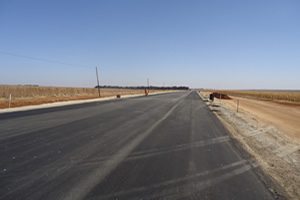 Rehabilitation of sinkholes on the N14 near Carletonville on Schedule
Rehabilitation of sinkholes on the N14 near Carletonville on Schedule
The Gautrans- SANRAL- Aurecon collaboration has seen the successful progression of the rehabilitation and repair of the N14 route approximately 20 km north of Merafong/ Carletonville on the border between Gauteng and North West.
The area is prone to sinkholes and between the end of December 2007 and the beginning of January 2008, three sinkholes formed on the road shoulder resulting in the closure of a 14km stretch with traffic being diverted along existing routes. Two of the sinkholes were about 10m in diameter and the third one was 4m in diameter.
For Sinkholes to form it is normally determined by the erosion potential of material above dolomite bed-rock and by the presence of cavities. Common trigger mechanisms for erosion are poor surface drainage, lowering of groundwater level, and gravity. The triggers are moderated where a significant thickness of material with low erosion potential occurs above cavities or where cavities occur below groundwater level.
The scope of works being done under the supervision of Aurecon entailed Sinkhole rehabilitation through dynamic compaction (DC); compaction of the wider area using DC; cavity filling through compaction grouting; upgrade of stormwater drainage and the construction of the road.
Rehabilitation: Dynamic Compaction (DC)
Rehabilitation of the sinkholes was carried out using the filter inverted method using dynamic compaction (DC) and the method is designed to prevent future mobilisation of backfilled material. The use of DC backfilling ensures that people are not exposed to further collapse of the sinkhole during backfilling and compaction.
A 12 tonne pounder was dropped through a height of 18m on a 5m grid for primary compaction, and a 5m grid shifted 2.5 m diagonally, for secondary compaction followed by ironing blows. The intention with DC at the sinkhole area was to rehabilitate sinkholes and to reduce the permeability of near-surface materials.
Compaction Grouting- cavity filling
Drilling of the 116 percussion holes required, started in mid-November 2012 in the proximity of the sinkholes formed in the road reserve of the N14 and continued for three and a half months. Each nominal 114mm hole was backfilled with a grout mix with a specific slump value, specified by the geotechnical engineers and tested by Geomechanics (Pty) Ltd beforehand.
The proposed maximum volumes versus the grout pressures to be applied were determined by the Engineer beforehand based on the drilling results and treatment objectives. The aim was to fill the larger voids in the dolomite and improve the stability of the area in terms of future sinkhole damage. In total the project entailed drilling of 2666 m³ and pumping of 406, 98 m³ of specially designed and monitored grout.
The Superock percussion rig employed by Geomechanics was equipped with a Jean Lutz electronic data capturing system which kept a continuous record of the following major drilling elements: Penetration rate (m/h and min/m), torque (Nm), rpm, rotation energy (MJ/m³), air flow (m³/s), air pressure (N/m²), thrust and retaining pressure, and a vibralog assisting the Engineer to assess the physical properties of the materials encountered more accurately. In addition, conventional hand-held stopwatch and visual recording were also reported.
Each percussion hole, once completed, was equipped with BX drill casing (nominal 73, 2 mm od. and 64, 9 mm id) to within 6 meters of the bottom of the hole. This casing was used as a conduit for the grout. On delivery, each load of the prescribed grout was tested for slump value before being pumped into the hole. The Schwing piston grout pumps were equipped with an electronic Red Lion automatic data recording system which recorded the grout pressure, flow rate and volume per grout stage.
Once the predetermined volume or pressure criteria for satisfactory grout were reached, the BX casing was retracted by 1 meter and the process was repeated for next grouting stage. Records were produced indicating the volume and pressure achieved at each stage of the grouting process for each of the 116 holes.
The grout mixture prescribed by the engineering team presented challenges for the Geomechanics team. According to the site manager Dries de Beer, “The very rough sand used in the grout, separated from the cement every time the line needed to be flushed out. This separation caused a blockage when pumping resumed. To prevent this, we had to disconnect each individual line and clean it before pumping the next load of grout.”
These drilling and grouting operations were carried out in a rough concentric circle pattern starting on the outside of the grid pattern and working towards the center to ensure full coverage of the grout backfill over the whole area. No holes were drilled or grouted before previous holes had been fully grouted within a range closer than 6 meters to prevent any blowout due to inter hole connections. The area was also monitored daily to see if there was any lift in the ground from below caused by the grouting. By end of February 2013 the entire plotted area of 525m2 had been drilled and filled for improved stability.
The completion date of the project with an estimated budget of R139 million has been extended to the last quarter of 2013, due to the additional preventative work that has been assigned to the project team. Upon completion of the 14.06 km stretch of the road, motorist will benefit from the road built in line with SANRAL specifications. The travel time will also be reduced.
Contributors:
Lloyd Feshete, Chief Engineer. Krugersdorp Region, Gautrans.
Johan van der Merwe, Civil Technician. Aurecon
Braddley Prigge, KPMM Construction
Dave Rossitter. Geomechanics
